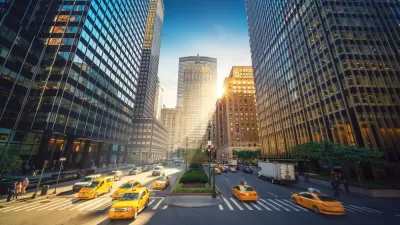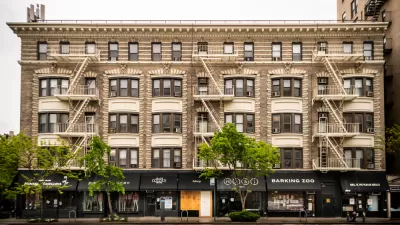The economic downturn and burst of the real estate bubble have thrown a wrench into New York City's broad plans for redevelopment and environmental redesign. This piece looks at what lies ahead for the city.
"All of Bloomberg's mega-projects are now indefinitely delayed, victims, in part, of the credit crunch and the mounting municipal deficit. Even if he's elected to a third term, the mayor probably won't ever realize his grand vision for New York. And yet his legacy is already visible on the city's landscape. It is less sweeping, perhaps, but no less significant: he empowered the private sector to remake the city bit by bit."
"You don't have to be an architect or an urban planner to recognize how much the city was transformed along the way. Walk around most neighborhoods in Manhattan and many neighborhoods in the outer boroughs, and you will be confronted with new construction, whether the steel-and-glass condominium complexes that tower above the old factories and warehouses on the rezoned waterfront of Greenpoint and Williamsburg; the 43-story headquarters for Goldman Sachs that recently sprouted in Lower Manhattan (thanks, in part, to a generous financial incentive from the city); or the two virgin ballparks where the Yankees and Mets will soon open their 2009 seasons (with the help of big municipal tax breaks and an enormous infrastructure investment in the stadium's respective neighborhoods)."
"Since November, some $5 billion worth of development has been delayed or canceled. New York is again a city of abandoned lots, half-finished buildings and free-floating anxiety."
"The downturn will give New York a chance to pause and reflect on this period of hyperactive development, and to think about what sort of buildings it needs in the future."
FULL STORY: After the Bubble

Maui's Vacation Rental Debate Turns Ugly
Verbal attacks, misinformation campaigns and fistfights plague a high-stakes debate to convert thousands of vacation rentals into long-term housing.

Planetizen Federal Action Tracker
A weekly monitor of how Trump’s orders and actions are impacting planners and planning in America.

In Urban Planning, AI Prompting Could be the New Design Thinking
Creativity has long been key to great urban design. What if we see AI as our new creative partner?

Massachusetts Budget Helps Close MBTA Budget Gap
The budget signed by Gov. Maura Healey includes $470 million in MBTA funding for the next fiscal year.

Milwaukee Launches Vision Zero Plan
Seven years after the city signed its Complete Streets Policy, the city is doubling down on its efforts to eliminate traffic deaths.

Portland Raises Parking Fees to Pay for Street Maintenance
The city is struggling to bridge a massive budget gap at the Bureau of Transportation, which largely depleted its reserves during the Civd-19 pandemic.
Urban Design for Planners 1: Software Tools
This six-course series explores essential urban design concepts using open source software and equips planners with the tools they need to participate fully in the urban design process.
Planning for Universal Design
Learn the tools for implementing Universal Design in planning regulations.
Gallatin County Department of Planning & Community Development
Heyer Gruel & Associates PA
JM Goldson LLC
City of Camden Redevelopment Agency
City of Astoria
Transportation Research & Education Center (TREC) at Portland State University
Jefferson Parish Government
Camden Redevelopment Agency
City of Claremont





























